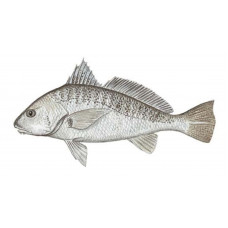Latin name
Micropogonias undulatus
Other names
Сroaker, crocus, golden cracker, hardhead, king billy, ishimoki, corvina, corbina, corvinón brasileño.
Identification
Body is rather massive, back is elevated and compressed. Head is long, snout is protruded forward above jaws. Mouth rather large. Antenna bone is strongly serrate. Teeth are tufted, arranged in the form of bands. Teeth of the external row on the upper jaw are enlarged. On each side of the lower jaw is a row of very tiny antennae. The spines of the dorsal fin are fairly strong. Caudal fin with two shallow notches. Has a high first dorsal fin and a long, low second dorsal fin. The chin has 6 to 10 tiny barbs. The middle rays of the caudal fin are longer than the upper and lower, creating a wedge-shaped appearance. The coloration is greenish above and white below, with brownish-black spots and a silvery shimmer on the body. There are dark wavy lines on the sides. During spawning, the Atlantic croaker takes on a bronze hue (hence the nickname "golden croaker") and its pelvic fins turn yellow.
Distribution
It is found along the Atlantic coast from Cape Cod to the Gulf of Campeche. It is abundant along the entire Gulf coast, occasionally in Louisiana and Mississippi waters.
Habitat
The Atlantic croaker is an estuarine bottom-dwelling fish that goes into the ocean during spawning. It prefers muddy, sandy and shell bottoms, areas around rocks, waters near piers, piers and bridges, as well as the surf. Juveniles inhabit both open and vegetated shallow marshes. Adult croaker can inhabit a wide range of salinity at temperatures from 50° to 96 °F. Large fish are not found at temperatures below 50 °F. However, larvae and juveniles are more tolerant of lower temperatures.
Size
The average fish reaches 12 inches in length and weighs 11⁄2 pounds, can grow up to 20 inches. The record weight of a fish caught is 5 pounds 8 ounces. It can live up to 5 years.
Life history and Behavior
Spawning occurs at sea in winter and spring (peak month is November), the Atlantic croaker migrates to deeper and warmer waters. Presumably, croaker spawn in the open Gulf of Mexico, near the mouths of various passages leading into shallow bays and lagoons. Adults migrate in small groups to the bays in the spring and leave the marshes in the fall to enter the deeper waters of the Gulf.
Food and feeding habits
It eats small fish and crustaceans in large quantities, mollusks, algae in small quantities. Juveniles feed mainly on zooplankton. Adults feed on detritus, larger invertebrates and fish. Sensory barbs allow the Atlantic croaker to find food on the bottom.
Reproduction
Some of them spawn at depths of about 80 m, but the bulk of them spawn at depths of less than 20 m. In the Gulf of Mexico, larvae are carried into estuaries by tidal and wind currents and remain there all winter. In late spring and early summer, juveniles emerge from estuaries into the coastal waters of the Gulf.
| Classification | |
| Phylum | Chordata |
| Class | Actinopterygii |
| Squad | Acanthuriformes |
| Family | Sciaenidae |
| Genus | Micropogonias |
| Species | Acanthuriformes |
| Features | |
| Conservation status | Least Concern |
| Habitat | bottom |
| Life span, years | 5 |
| Maximum body weight, kg | 0.227 |
| Maximum length, cm | 152 |
| Sailing speed, m/s | No information |
| Threat to people | Edible |
| Way of eating | Planktonophage |



